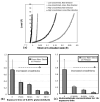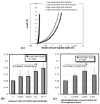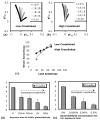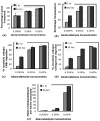Structural mechanism for alteration of collagen gel mechanics by glutaraldehyde crosslinking
- PMID: 22775003
- PMCID: PMC3825191
- DOI: 10.3109/03008207.2011.640760
Structural mechanism for alteration of collagen gel mechanics by glutaraldehyde crosslinking
Abstract
Soft collagenous tissues that are loaded in vivo undergo crosslinking during aging and wound healing. Bioprosthetic tissues implanted in vivo are also commonly crosslinked with glutaraldehyde (GA). While crosslinking changes the mechanical properties of the tissue, the nature of the mechanical changes and the underlying microstructural mechanism are poorly understood. In this study, a combined mechanical, biochemical and simulation approach was employed to identify the microstructural mechanism by which crosslinking alters mechanical properties. The model collagenous tissue used was an anisotropic cell-compacted collagen gel, and the model crosslinking agent was monomeric GA. The collagen gels were incrementally crosslinked by either increasing the GA concentration or increasing the crosslinking time. In biaxial loading experiments, increased crosslinking produced (1) decreased strain response to a small equibiaxial preload, with little change in response to subsequent loading and (2) decreased coupling between the fiber and cross-fiber direction. The mechanical trend was found to be better described by the lysine consumption data than by the shrinkage temperature. The biaxial loading of incrementally crosslinked collagen gels was simulated computationally with a previously published network model. Crosslinking was represented by increased fibril stiffness or by increased resistance to fibril rotation. Only the latter produced mechanical trends similar to that observed experimentally. Representing crosslinking as increased fibril stiffness did not reproduce the decreased coupling between the fiber and cross-fiber directions. The study concludes that the mechanical changes in crosslinked collagen gels are caused by the microstructural mechanism of increased resistance to fibril rotation.
Conflict of interest statement
The authors report no conflicts of interest. The authors alone are responsible for the content and writing of the paper.
Figures








Similar articles
-
Biaxial mechanical/structural effects of equibiaxial strain during crosslinking of bovine pericardial xenograft materials.Biomaterials. 1999 Jan;20(2):137-53. doi: 10.1016/s0142-9612(98)00142-2. Biomaterials. 1999. PMID: 10022783
-
The chemical protecting group concept applied in crosslinking of natural tissues with glutaraldehyde acetals.Artif Organs. 1998 Mar;22(3):210-4. doi: 10.1046/j.1525-1594.1998.06006.x. Artif Organs. 1998. PMID: 9527281
-
A fibril-based structural constitutive theory reveals the dominant role of network characteristics on the mechanical behavior of fibroblast-compacted collagen gels.Biomaterials. 2015 Oct;67:365-81. doi: 10.1016/j.biomaterials.2015.07.038. Epub 2015 Jul 21. Biomaterials. 2015. PMID: 26247391
-
Chemical crosslinking of biopolymeric scaffolds: Current knowledge and future directions of crosslinked engineered bone scaffolds.Int J Biol Macromol. 2018 Feb;107(Pt A):678-688. doi: 10.1016/j.ijbiomac.2017.08.184. Epub 2017 Sep 14. Int J Biol Macromol. 2018. PMID: 28919526 Review.
-
In the beginning there were soft collagen-cell gels: towards better 3D connective tissue models?Exp Cell Res. 2013 Oct 1;319(16):2460-9. doi: 10.1016/j.yexcr.2013.07.001. Epub 2013 Jul 12. Exp Cell Res. 2013. PMID: 23856376 Review.
Cited by
-
A Comparative Evaluation of the Mechanical Properties of Two Calcium Phosphate/Collagen Composite Materials and Their Osteogenic Effects on Adipose-Derived Stem Cells.Stem Cells Int. 2016;2016:6409546. doi: 10.1155/2016/6409546. Epub 2016 Apr 28. Stem Cells Int. 2016. PMID: 27239204 Free PMC article.
-
Crosslinker-free collagen gelation for corneal regeneration.Sci Rep. 2022 Jun 1;12(1):9108. doi: 10.1038/s41598-022-13146-9. Sci Rep. 2022. PMID: 35650270 Free PMC article.
-
Optimization of Collagen Chemical Crosslinking to Restore Biocompatibility of Tissue-Engineered Scaffolds.Pharmaceutics. 2021 Jun 3;13(6):832. doi: 10.3390/pharmaceutics13060832. Pharmaceutics. 2021. PMID: 34204956 Free PMC article.
-
Inelastic behaviour of collagen networks in cell-matrix interactions and mechanosensation.J R Soc Interface. 2015 Jan 6;12(102):20141074. doi: 10.1098/rsif.2014.1074. J R Soc Interface. 2015. PMID: 25392399 Free PMC article.
-
Experimental Investigation on the Penetrability Mechanism of Gel Slug During Well Completion Processes.ACS Omega. 2023 Jun 15;8(25):23112-23119. doi: 10.1021/acsomega.3c02494. eCollection 2023 Jun 27. ACS Omega. 2023. PMID: 37396226 Free PMC article.
References
-
- Brinckmann J, Notbohm H, Müller PK, editors. Collagen - primer in structure, processing and assembly. Springer; 2005.
-
- Stenzel KH, Miyata T, Rubin AL. Collagen as a biomaterial. Annual Review of Biophysics and Bioengineering. 1974;3(1):231–53. - PubMed
-
- Eyre DR, Paz MA, Gallop PM. Cross-Linking in Collagen and Elastin. Annual Review of Biochemistry. 1984;53(1):717–48. - PubMed
-
- McCormick RJ, Thomas DP. Collagen crosslinking in the heart: relationship to development and function. Basic Appl Myol. 1998;8(2):143–50.
Publication types
MeSH terms
Substances
Grants and funding
LinkOut - more resources
Full Text Sources
Other Literature Sources
